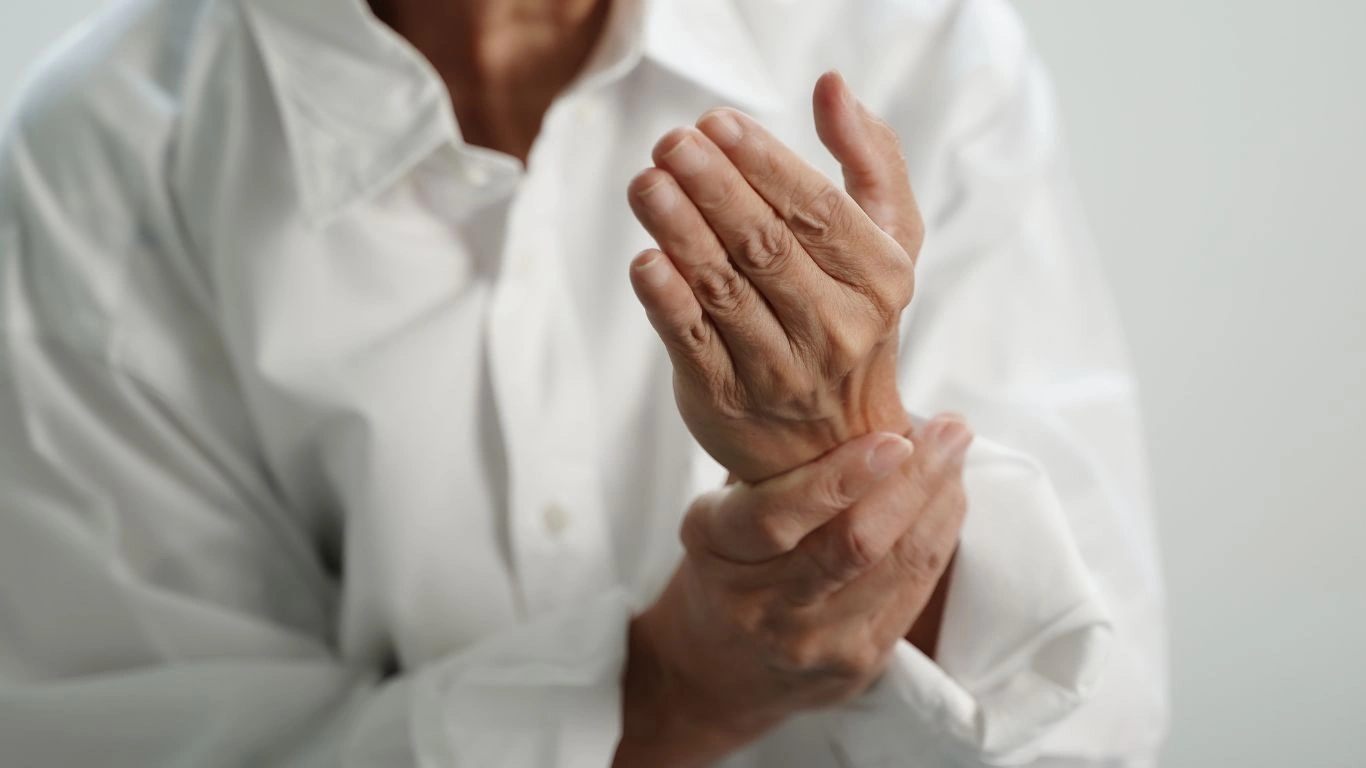How Rheumatoid Arthritis Affects Muscle Strength and Endurance
Living with rheumatoid arthritis (RA) isn’t just about managing joint pain; it affects so much more. One often-overlooked consequence is how rheumatoid arthritis impacts muscle strength and endurance. As a rheumatoid arthritis expert, I’ve seen firsthand how this condition can severely alter a person’s physical capabilities. What many people don’t realize is that the effects of RA aren’t confined to the joints alone. The inflammation that occurs as part of this autoimmune disease can cause a cascade of problems throughout the body. This goes beyond the usual pain and stiffness you might expect, influencing muscle health, strength, and overall endurance. So, how exactly does rheumatoid arthritis affect muscle strength and endurance? Let’s dive in.
Understanding the Connection Between RA and Muscle Weakness

Rheumatoid arthritis is a systemic disease, meaning it doesn’t just affect the joints. It also impacts other systems, including the muscles. When RA flares up, the inflammation isn’t limited to the joints alone. It spreads throughout the body, including the muscles and surrounding tissues. This systemic inflammation plays a huge role in the deterioration of muscle strength and function over time. The chronic nature of RA means that muscles can start to atrophy (waste away) because they aren’t being used as effectively or as frequently as they should be.
From my experience, muscle weakness in RA patients is common. It can happen for a few different reasons. First, there’s the direct effect of inflammation. Inflammatory cytokines (the proteins involved in inflammation) are known to affect muscle tissue, leading to muscle degradation. Second, there’s the indirect effect. When joints are painful or swollen, many people naturally avoid using those joints, which results in less activity and, in turn, weaker muscles.
The Role of Inflammation in Muscle Loss

Let’s get a little more into the science behind it. Inflammation is a key player in rheumatoid arthritis, but it’s also a culprit when it comes to muscle loss. In RA, the immune system mistakenly attacks healthy tissue, which causes persistent inflammation in the joints. But did you know this inflammation doesn’t stay confined to the joints? It actually spreads to the muscles, making them weaker over time.
The muscles around the affected joints are often the first to feel the strain. As inflammation in the joints increases, the muscles surrounding them work harder to compensate, leading to muscle fatigue and eventually muscle wasting. This is why many people with RA experience a noticeable decrease in muscle strength, especially in the arms, legs, and core. The longer the inflammation persists, the more pronounced this muscle weakness becomes.
Muscle Endurance: Why It’s So Important
When you think of muscle strength, you might focus on how much weight you can lift or how much force you can exert. But muscle endurance is just as crucial for daily activities. Muscle endurance refers to how long a muscle can sustain a contraction or continue performing a task before it fatigues. For people with rheumatoid arthritis, this can be a significant issue.
RA-related muscle weakness can lead to decreased endurance, making it harder to engage in physical activities like walking, climbing stairs, or even standing for prolonged periods. In fact, muscle endurance is often the first thing to go when someone with RA begins to experience muscle weakness. This decline in stamina can severely impact an individual’s ability to complete daily tasks, affecting their independence and quality of life.
Why RA Patients Struggle with Physical Activity

Another factor to consider is the natural reluctance to engage in physical activity when living with RA. It’s a catch-22 situation: when you’re in pain, it’s hard to find the motivation to move. Yet, avoiding physical activity can actually make things worse. A lack of movement leads to even more muscle weakness and stiffness, perpetuating the cycle.
One of the key factors that influence muscle strength and endurance in RA patients is how much they are able to exercise. But as I’ve often discussed with my patients, it’s not about pushing yourself to extremes. It’s about finding that balance. When you don’t move enough, muscles weaken. But when you push too hard, you can trigger more inflammation and worsen the condition. This is where personalized care and a tailored exercise plan can make a big difference.
What Happens When You Don’t Exercise Enough?
- Muscle Atrophy: The muscles begin to shrink due to lack of use.
- Stiffness: Without regular movement, the muscles become stiff and less flexible.
- Joint Instability: Weaker muscles can lead to less support for the joints, causing increased risk of injury or further joint damage.
- Decreased Stamina: Over time, muscles lose their ability to sustain activity, making simple tasks feel exhausting.
It’s important to remember that while it can be tough to get started, even small amounts of gentle exercise can help improve muscle strength and endurance. And you don’t need to become a marathon runner or gym enthusiast to see benefits. A little bit of consistent movement goes a long way in improving your muscle function and overall well-being.
The Psychological Impact of Muscle Weakness in RA
Another aspect I’ve seen in my practice is the psychological toll that muscle weakness and endurance issues can take on someone with rheumatoid arthritis. Feeling like you can’t keep up with others or that your body isn’t functioning the way it should can lead to frustration, anxiety, or even depression. It’s easy to feel isolated when you struggle to do the simple things in life, like lifting your groceries or playing with your kids.
It’s important to acknowledge this aspect of RA as well. Muscle weakness isn’t just a physical problem—it’s an emotional and mental challenge too. And addressing it requires a holistic approach, focusing not just on physical rehabilitation, but also on emotional support, coping strategies, and psychological well-being.
Next, we’ll explore practical solutions and tips for managing muscle strength and endurance in RA patients, focusing on exercises, therapies, and lifestyle changes that can make a real difference.
Strategies for Improving Muscle Strength and Endurance with RA

Now that we’ve discussed how rheumatoid arthritis can impact muscle strength and endurance, let’s shift gears and talk about some practical solutions. It’s not all doom and gloom—there are plenty of strategies that can help improve muscle function and keep you moving. The key is finding a balance that works for your body. Over the years, I’ve helped many patients manage this balance, and the results can be incredibly empowering. Here are some strategies that can make a world of difference when it comes to building back muscle strength and improving endurance.
1. Start Slowly with Gentle Exercises
When you’re dealing with RA, one of the biggest mistakes people make is jumping into intense workouts or pushing their bodies too hard too soon. Trust me, I’ve seen it time and time again. Patients get excited about feeling a little better and then try to do too much, only to suffer a flare-up shortly after. It’s all about pacing yourself.
Gentle exercises like walking, swimming, or light stretching are a great starting point. These activities are low-impact but still help build endurance. And here’s the thing—when you exercise gently, it stimulates blood flow to your muscles, helping them stay healthy without putting unnecessary stress on the joints. This is vital for managing both your muscle strength and your overall RA symptoms.
2. Strength Training for RA
Yes, you can still do strength training with rheumatoid arthritis! The trick is to adjust the intensity and choose the right exercises that won’t aggravate your condition. Strengthening your muscles isn’t just about building bigger muscles, it’s about stabilizing the joints and improving your overall mobility. It’s something I always recommend to my patients, especially those who are starting to experience muscle weakness.
Strength training exercises like resistance bands, bodyweight exercises (think squats or wall push-ups), and light dumbbells can help improve muscle mass. These exercises don’t need to be heavy-duty to be effective. The goal here is to gradually build strength without overloading your muscles or joints.
3. Focus on Flexibility and Mobility
Flexibility is often overlooked, but it’s such an important part of keeping muscles strong and functional. When you’ve got RA, muscle stiffness and tightness can become a real problem, but regular stretching helps keep everything loose and limber. In my experience, patients who prioritize flexibility tend to feel less stiff and have better range of motion in their joints.
Incorporating flexibility exercises like yoga or tai chi can help with both flexibility and balance, which in turn helps with muscle endurance. These exercises work wonders for improving posture, preventing injury, and helping muscles work more efficiently. Yoga, especially, is something I often suggest because it’s gentle yet effective for RA patients, focusing on joint mobility, stretching, and deep breathing.
Nutrition and RA: Supporting Muscle Health from the Inside

Muscle health isn’t just about exercise; what you put into your body matters too. Good nutrition plays a pivotal role in managing RA and supporting muscle strength. Over the years, I’ve learned that diet can have a profound effect on the severity of inflammation and overall physical performance in RA patients. By focusing on anti-inflammatory foods and getting enough nutrients, you can help reduce inflammation and support muscle repair and growth.
Key Nutrients for Muscle Health
Some key nutrients I always talk to my patients about include:
- Protein: Muscles need protein to rebuild and repair. Make sure you’re consuming enough lean protein sources like chicken, fish, tofu, and legumes.
- Omega-3 Fatty Acids: These healthy fats are fantastic at reducing inflammation. Omega-3s, found in fatty fish (like salmon), flaxseeds, and walnuts, can help manage RA symptoms and improve muscle health.
- Vitamin D: Low vitamin D levels are linked to muscle weakness and increased inflammation. Be sure to get enough sun exposure or consider supplementation if necessary.
- Magnesium: This mineral is essential for muscle function and relaxation. It can help reduce muscle cramps and spasms that sometimes occur with RA.
It’s also important to limit processed foods, which tend to be high in sugar and unhealthy fats. These can contribute to inflammation and worsen RA symptoms over time. The goal is to focus on whole foods that nourish your body and reduce inflammation.
Hydration: Don’t Forget the Basics
It might sound simple, but hydration is often overlooked. Staying hydrated is crucial for maintaining muscle function. Dehydration can lead to muscle cramps, fatigue, and increased soreness, which can make exercise and movement even more difficult. I always remind my patients to drink plenty of water, especially when they’re exercising or experiencing a flare-up. Hydration helps keep the muscles lubricated, which can prevent stiffness and discomfort.
Supportive Therapies: Physical Therapy and Occupational Therapy

In addition to exercises and nutrition, there are several therapies that can play a huge role in managing muscle strength and endurance with RA. Physical therapy (PT) is one of the most effective treatments for RA-related muscle weakness. Physical therapists are trained to design personalized exercise programs that help build strength, improve joint mobility, and reduce pain.
PT typically starts with gentle range-of-motion exercises to improve flexibility and gradually moves on to strength-building exercises. What I love about physical therapy is that it’s customized to each patient’s unique needs and limitations, making it easier to track progress without risking further injury.
In addition to PT, occupational therapy (OT) can also help people with RA regain independence and improve muscle function. OT focuses on adapting daily activities to make them easier on the joints and muscles. For example, an OT might recommend assistive devices to help with tasks like dressing or cooking, or they might teach strategies for managing pain while doing everyday activities.
When combined with exercise, proper nutrition, and therapy, these approaches can have a tremendous positive impact on muscle strength and overall well-being. It’s all about making small but consistent changes that can lead to big improvements over time.
Daily Habits That Support Muscle Strength and Endurance in RA

So now that we’ve covered exercises, therapy, and nutrition, let’s talk about something just as important: your everyday habits. These seemingly small decisions you make on a daily basis can add up to big changes when it comes to how rheumatoid arthritis affects muscle strength and endurance. I often tell my patients that consistency is more powerful than intensity. You don’t have to go all in at once—you just need to keep going, one step at a time.
When you live with RA, every day can feel a little different. Some mornings you might wake up ready to take on the world, and others you may struggle just to get out of bed. That’s totally okay. The trick is to build routines that are flexible but still promote movement, strength, and overall energy.
Set Micro Goals You Can Actually Keep
This is something I personally recommend because I’ve seen it work wonders. Instead of setting massive goals like “I’ll walk 5 miles a day,” focus on micro goals: “I’ll stretch for 10 minutes in the morning,” or “I’ll stand up and move every hour.” These tiny habits are less intimidating and more realistic—and when done consistently, they boost both muscle strength and endurance over time.
Make it part of your routine. Tie your new habit to something you already do—like stretching while waiting for the kettle to boil, or doing a few leg raises during commercial breaks. It doesn’t have to be fancy to be effective.
Prioritize Sleep and Recovery
Here’s something people underestimate: rest is just as important as movement. Your muscles need time to recover, especially when dealing with inflammation from RA. If you’re constantly fatigued, your muscles don’t get the opportunity to rebuild and strengthen properly.
Try to establish a regular sleep schedule, limit blue light before bed, and make your sleeping environment comfortable and joint-friendly. I’ve had patients improve their energy levels and endurance dramatically just by tweaking their sleep habits. Remember, healing happens when you’re resting—not when you’re burning yourself out.
Listen to Your Body (No, Seriously)
You’ve probably heard this advice a million times, but it truly is gold—especially when it comes to rheumatoid arthritis and muscle health. One of the biggest hurdles I see is patients ignoring early signs of overexertion. It’s easy to get frustrated and try to push through the pain, but that usually backfires. Trust me, your body will thank you later if you learn how to recognize the difference between soreness from activity and pain from inflammation.
Use tools like pain journals or even simple daily check-ins with yourself to track how you’re feeling. If something doesn’t feel right, adjust. And don’t be afraid to communicate this to your healthcare provider—it helps us help you better.
Assistive Tools and Tech That Can Help

Another often overlooked yet super valuable area is the use of assistive devices and technology. From braces and ergonomic tools to smart fitness trackers and mobile apps, there are so many ways tech can support muscle strength and endurance in day-to-day RA management.
- Ergonomic Tools: Adaptive tools like jar openers, ergonomic handles, and reachers help reduce joint strain and allow you to stay active longer.
- Fitness Trackers: Devices like Fitbits or Apple Watches help monitor your steps, heart rate, and even sleep. It’s a great way to stay accountable and notice patterns.
- Resistance Bands: Lightweight and portable, these are excellent for at-home strength training without stressing the joints.
- Joint Braces: These provide additional support, especially during flare-ups, helping protect muscles and reduce fatigue.
I always encourage patients to embrace what works for them. If a little bit of tech makes it easier to stick with a program or track your progress, go for it. The goal is to create a support system around your daily life that makes you feel empowered—not restricted.
Emotional Strength Is Part of the Journey Too
Here’s something a lot of people don’t talk about enough: the emotional toll of feeling physically weak. It’s something I’ve witnessed in so many of my patients—and honestly, it’s something I’ve had to work through with them time and again. Losing strength or stamina can feel like losing independence, and that can affect your confidence, your mood, and even your social life.
That’s why emotional support is so crucial. Whether it’s joining a support group, talking to a therapist, or just chatting with a friend who understands, make space for that kind of care. Emotional endurance supports physical endurance. You can’t separate the two when managing a chronic condition like RA.
References
Disclaimer
This article is based on professional experience and existing research but is intended for informational purposes only. It does not replace personalized medical advice. Always consult with a healthcare provider before starting any new treatment, exercise routine, or nutritional program—especially if you’re managing a chronic condition like rheumatoid arthritis.

Tarra Nugroho is a dedicated Nurse Practitioner with a strong foundation in family and preventive care. She brings both compassion and clinical expertise to her practice, focusing on patient-centered care and health education. As a contributor to Healthusias.com, Tarra translates medical knowledge into clear, empowering articles on topics like women’s health, chronic disease management, and lifestyle medicine. Her mission is simple: help people feel seen, heard, and informed—both in the clinic and through the content she creates. When she’s not caring for patients, Tarra enjoys weekend hikes, plant-based cooking, and curling up with a good health podcast.






